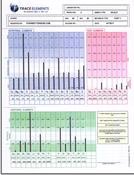Hair Tissue Mineral Analyses (HTMA)
A hair tissue mineral analysis provides a unique reading of heavy metal and mineral levels in the cells over a two to three month period. It takes into consideration that toxins are stored in the tissues of the body, not in the blood. For instance, you can have normal copper levels in the blood, but high copper levels in the tissues.
The reason hair is used for testing mineral status and metabolic activity is because of its very nature. Our hair is formed from clusters of specialized cells that make up the hair follicle. During the growth phase, the hair is exposed to the internal environment such as blood, lymph and extra-cellular fluids. As the hair continues to grow and reaches the surface of the skin, its outer layers harden, locking in the metabolic products accumulated during the period of formation. This biological processs provides a blueprint and lasting record of metal content and nutritional metabolic activity that has occured during this time.
The precise analytical method of determining the levels of minerals in the hair is a highly sophisticated technique: when performed to exacting standards and interpreted correctly, it may be used as a screening aid for determining mineral deficiencies, excesses, and/or imbalances. HTMA provides you and your healthcare professional with an economical and sensitive indicator of the long-term effects of diet, stress, toxic metal exposure and their effects on your child's mineral balance that is difficult to obtain through other clinical tests.
It is important for the attending healthcare professional to determine the mineral status as minerals are absolutely critical for life and abundant health. They are involved in and are necessary for cellular metabolism, structural support, nerve conduction, muscular activity, immune functions, anti-oxidant and endocrine activity, enzyme functions, water and acid/alkaline balance and even DNA function.
Many factors can affect mineral nutrition, such as: food preparation, dietary habits, genetic and metabolic disorders, disease, medications, stress, environmental factors, as well as exposure to heavy metals. Rarely does a single nutrient deficiency exist in a person. Multiple nutritional imbalances however are quite common, contributing to an increased incidence of adverse health conditions. In fact, it is estimated that mild and sub-clinical nutritional imbalances are up to ten times more common than nutritional deficiencies alone.
To get an idea of how helpful a hair tissue analysis can be, think about this: Researchers using tissue mineral analysis determined, more than 100 years after Napoloen Bonaparte's death, that he had been poisoned by arsenic. Even though his hair sample was tested more than a century after his death, it still revealed pathological amounts of arsenic that had gradually proved fatal. |





 FEATURE ARTICLES
FEATURE ARTICLES


